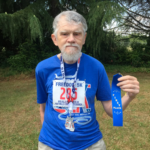 If you have lived long enough, you have seen first your grandparents, and then your parents become weaker, slower, and less capable as they grow older. Why does this happen? There are several competing theories that try to explain the root cause of this phenomenon, which seems universal and unavoidable. There is no consensus on which, if any, of these theories are correct. However, there are some things that we do know.
If you have lived long enough, you have seen first your grandparents, and then your parents become weaker, slower, and less capable as they grow older. Why does this happen? There are several competing theories that try to explain the root cause of this phenomenon, which seems universal and unavoidable. There is no consensus on which, if any, of these theories are correct. However, there are some things that we do know.
One important clue to the process can be found in the cells of our bodies. When we are young, our bodies operate like finely tuned machines. Each cell has a job to do, and it does it, efficiently and thoroughly. As time goes by, some of those cells stop doing their jobs and instead, get in the way of the cells that are still working. This process is called cellular senescence. Senescent cells compound the problem by secreting toxic substances into the environment around them, impeding the function of other cells.
One of the interventions currently being studied by gerontologists, called senolytics, is the process of selectively removing senescent cells from the body. This intervention is still in its infancy and will probably not be a part of standard clinical practice for quite a while yet. This prompts the question, “Is there something that I can do now to reduce the burden of senescent cells in my body?” A recent research study gives us a glimpse of something worth trying that is neither hard nor expensive. The research was conducted by a group led by Nathan K. Brasseur at the Mayo Clinic. The article, titled “Exercise reduces circulating biomarkers of cellular senescence in humans,” chronicling the research, appeared in Aging Cell in May 2021. The title of the paper, gives away the secret: exercise.
The researchers put 34 older adults, with an average age of 67 years, through a 12-week structured exercise program of progressive strength and endurance training, twice a week. Testing for blood biomarkers of senescent cells both before and after the intervention, showed a consistent reduction in the biomarkers that are produced by senescent cells.
What can we conclude from this result? It appears that the exercise program resulted in a blood profile of the older adult test subjects that was younger than the profile that they had before starting the exercise program. As far as their body was concerned, they were younger after a twelve-week program of endurance and strength training than they had been before starting the program.
Twelve weeks is long enough to establish a habit. One wonders how much benefit these people would accrue by keeping the program up after the twelve-week program was completed. This seems like a no-brainer. Spending an hour or two every week in strength and endurance training could pay off big time in quality of life, not to mention length of quality life.
BIO:
Allen G. Taylor is a 40-year veteran of the computer industry and the author of over 40 books, including Develop Microsoft HoloLens Apps Now, Get Fit with Apple Watch, Cruise for Free, SQL For Dummies, 9th Edition, Crystal Reports 2008 For Dummies, Database Development For Dummies, Access Power Programming with VBA, and SQL All-In-One For Dummies, Third Edition. He lectures internationally on astronomy, databases, innovation, and entrepreneurship. He also teaches database development and Crystal Reports through a leading online education provider. For the latest news on Allen’s activities, check out his blog at wwwallengtaylor.com or contact him at allen.taylor@ieee.org.